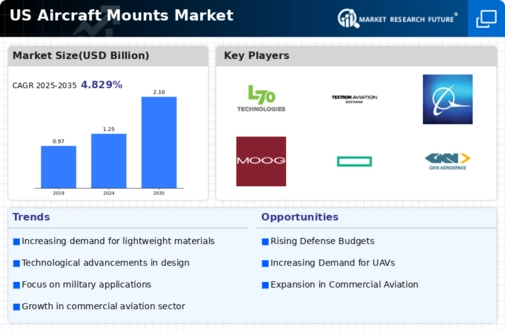Increased Defense Spending
The aircraft mounts market is likely to benefit from the rising defense budgets in the US. With a focus on modernizing military capabilities, the US government has allocated substantial funds for upgrading existing aircraft and developing new platforms. This trend is expected to drive demand for advanced aircraft mounts, which are essential for integrating various systems and payloads. In 2025, defense spending is projected to reach approximately $800 billion, indicating a robust investment in military aviation. Consequently, the aircraft mounts market may experience significant growth as defense contractors seek innovative solutions to enhance operational efficiency and effectiveness.
Growth in Commercial Aviation
The aircraft mounts market is poised for expansion due to the resurgence of the commercial aviation sector. As air travel demand continues to recover, airlines are investing in fleet upgrades and new aircraft acquisitions. This trend is reflected in the projected growth of the commercial aviation market, which is expected to reach $1 trillion by 2026. Aircraft mounts play a crucial role in ensuring the safe and efficient operation of various onboard systems, including avionics and cargo management. Therefore, the aircraft mounts market is likely to see increased orders from commercial airlines seeking to enhance their operational capabilities.
Emergence of Advanced Materials
The aircraft mounts market is influenced by the ongoing development of advanced materials that enhance performance and reduce weight. Innovations in composite materials and lightweight alloys are becoming increasingly prevalent in aircraft design, leading to a demand for compatible mounting solutions. These materials not only improve fuel efficiency but also contribute to overall aircraft performance. As manufacturers adopt these advanced materials, the aircraft mounts market must adapt to provide mounts that meet the evolving specifications. This shift could potentially lead to a market growth rate of around 5% annually as manufacturers seek to optimize aircraft performance.
Integration of Smart Technologies
The aircraft mounts market is experiencing a shift towards the integration of smart technologies, which enhance operational efficiency and data management. The incorporation of sensors and IoT capabilities into aircraft mounts allows for real-time monitoring and diagnostics, improving maintenance practices and reducing downtime. As airlines and military operators seek to leverage data analytics for better decision-making, the demand for smart mounts is likely to rise. This trend suggests that the aircraft mounts market could see a growth trajectory of approximately 6% over the next few years, driven by the need for smarter, more connected aviation solutions.
Regulatory Compliance and Safety Standards
The aircraft mounts market is significantly impacted by stringent regulatory compliance and safety standards imposed by aviation authorities. In the US, the Federal Aviation Administration (FAA) mandates rigorous testing and certification processes for aircraft components, including mounts. This regulatory environment drives manufacturers to innovate and enhance the safety and reliability of their products. As the industry adapts to these regulations, the aircraft mounts market may witness increased investments in research and development to ensure compliance. This focus on safety could lead to a more competitive market landscape, with companies striving to meet or exceed regulatory requirements.






















Leave a Comment